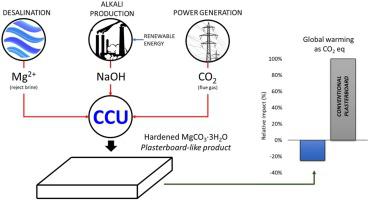Journal of CO2 Utilization ( IF 7.7 ) Pub Date : 2021-04-19 , DOI: 10.1016/j.jcou.2021.101545 José-Luis Gálvez-Martos , Roneta Chaliulina , Enrique Medina-Martos , Ammar Elhoweris , Amer Hakki , Jonathan Mwanda , Yousef Al-Horr

|
Carbon capture and utilization, CCU, has a great potential for the improvement of the environmental profile of products and services. This is the case for construction materials, which are able to sequester an enormous amount of carbon dioxide in the form of usable products, providing a long-term capacity for storage of CO2.
In a recent approach, a solid carbonate, MgCO3·3H2O (nesquehonite) was discovered to have cementitious behaviour, similar to gypsum plaster, in its phase transitions in dehydration-rehydration cycles, or during direct conversion to other carbonates.
This solid can be obtained by reacting, in alkaline environments, CO2 from industrial gas streams and magnesium from desalination brines.
This study aims the life cycle and eco-efficiency of such material using a standardised approach. The geographical scope is the State of Qatar, where desalination and power generation are located in the same facility for heat integration, and where the current market conditions of construction material imports provide an excellent framework for a competitive case study.
The results show that the production of a plasterboard-like construction material based on the hardening of magnesium carbonate trihydrate is associated with less CO2 emissions than conventional gypsum-plasterboard production. For such achievement, the production system should introduce renewable energy as the source of electricity in the manufacture of the alkali used for the CO2 absorption in the carbon capture process. Also, process optimisation towards less demand of energy resources and the substitution of plaster and plasterboard products in real-life applications are essential to improve the eco-efficiency of the product.
中文翻译:

通过碳捕获和利用生产的新型建筑材料的生态效率
碳捕获和利用CCU在改善产品和服务的环境特征方面具有巨大潜力。建筑材料就是这种情况,该建筑材料能够以可用产品的形式隔离大量的二氧化碳,从而提供了长期存储CO 2的能力。
在最近的方法中,发现一种固态碳酸盐,MgCO 3 ·3H 2 O(锂蒙脱石)与石膏灰泥相似,在脱水-脱水循环中或在直接转化为其他碳酸盐的过程中具有胶结性。
该固体可以通过在碱性环境中使来自工业气流的CO 2与来自脱盐盐水的镁反应来获得。
这项研究使用标准化方法来研究此类材料的生命周期和生态效率。地理范围是卡塔尔国,那里的海水淡化和发电位于同一设施中以进行热集成,并且当前建筑材料进口的市场状况为竞争性案例研究提供了一个极好的框架。
结果表明,与传统的石膏-石膏板生产相比,基于碳酸三水合镁硬化的石膏板状建筑材料的生产与更少的CO 2排放相关。为了实现这一目标,生产系统应在制造用于碳捕集过程中吸收CO 2的碱的过程中引入可再生能源作为电力来源。此外,在现实生活中,朝着减少能源需求的过程进行优化以及在石膏和石膏板产品中替代石膏对提高产品的生态效率至关重要。


























 京公网安备 11010802027423号
京公网安备 11010802027423号